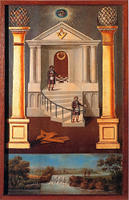I catalogue all the theology-related books here at the library, which is sometimes interesting and sometimes very much not. It does, however, mean that I'm the catch-all cataloguer for those very few books we order in relating to religions other than christianity,which is why earlier today I was flicking through Nevill Drury's Magic and Witchcraft: From Shamanism to the Technopagans, a broad history of magical theory and practice in human civilisation.
(A brief digression at this point: I don't, sadly, believe in the actual efficacy of magic -- let alone "magick" -- but I do find the theory fascinating. The symbolic schemas which people have constructed to interpret the world with the intention of influencing it can be enormously revealing about the way the human mind itself is made. I don't exclude science from this, although obviously I have opinions as to its effectiveness as compared with those of these rival systems.
This is why, as its readers can't have failed to notice, my short story "Minions of the Moon" draws extensively on medieval and renaissance alchemy and astrology: it's also why those who pay attention when The History of Christmas comes out -- or, of course, who've read this blog entry in the meantime -- may well spot names and ideas drawn from the Kabbalah in "The Long Midwinter". Give me time, and I'll almost certainly end up writing something based on the Tarot as well.)
Anyway. Flicking through the book, and specifically the chapter on Freemasonry, I was immediately struck by reproductions of three masonic "tracing boards" from 1819. (Tracing boards, as I've discovered since, are used as some kind of visual aid in masonic initiation rites. For some reason Drury calls them "training boards", which doesn't give me huge confidence in his scholarship, but I digress again.)
After some diligent work-avoidance I've managed to track down images of these same three boards on the web (click to see larger versions):


 Now, the reason these caught my eye is because as a student -- in common with a great many students -- I was a big fan of the work of René Magritte, the Belgian surrealist painter. (Yes, that's right, with the apples and the bowler hats.)
Now, the reason these caught my eye is because as a student -- in common with a great many students -- I was a big fan of the work of René Magritte, the Belgian surrealist painter. (Yes, that's right, with the apples and the bowler hats.)My immediate reaction on seeing the images out of context was that they had to be Magrittes: the po-faced illustrative style used to depict bizarre and eclectic assortments of objects, thus imbuing them with portentous significance, seemed like the work of no other artist I know (with the possible exception of Paul Delvaux). Compare the masonic images with Magritte's Personal Values, The Difficult Crossing or especially The Reckless Sleeper.
They're nothing to do with him, of course, as I discovered when I read the caption -- they come from Britain and predate him by eighty years.
Now, I'm no art historian, and I certainly haven't made a study of Magritte specifically, but I'm not aware of any suggestion that he had masonic connections. I seem to remember that it was part of the surrealists' approach to take the style of earlier Symbolist painters and strip it of content, replacing the supposedly meaningful symbols with random junk or the flotsam of the subconscious, as an absurdist or psychoanalytic statement... but I've never been aware of any suggestion that the symbology of Freemasonry played any part in inspiring this.
The similarity, though, is irresistible. Is it possible that Magritte, or someone in his family, had been a Freemason, and that his visual style was influenced by coming across some of these tracing boards early on in his career? Or is this just the kind of meaningless coincidence he would have loved?
It's enabled me to waste most of today fairly effectively, anyway.
I knew of Magritte before even seeing these earlier freemason paintings and felt the same thinking he must have been a freemason. seeing these earlier masonic paintings there is such similarity i thought they were by him. There are paintings which show single eyes like the masonic eye like in 'the philosiphers lamp' by magritte thats so masonic with the enlightenement philosophers! it also reminds me of elephants on parade
ReplyDelete